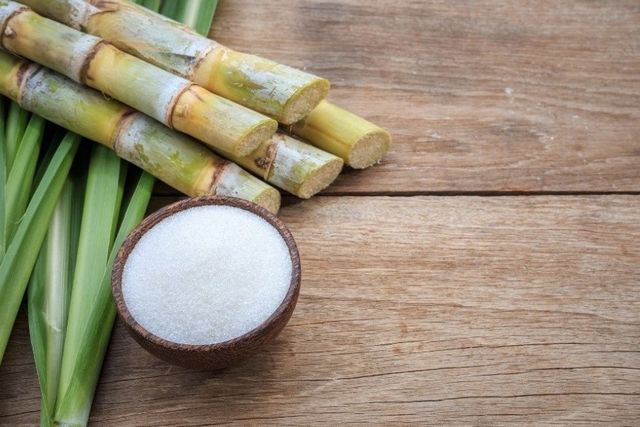A Thorough Overview to the Environmental Impact and Sustainability Practices in Cane Sugar Processing
The ecological influence of walking cane sugar processing provides a complicated selection of difficulties that warrant careful evaluation. From soil degradation and excessive water use to the carbon impact associated with cultivation and production, the consequences of traditional techniques are significant. What specific techniques can be carried out to strike a balance between efficiency and environmental stewardship?
Introduction of Walking Stick Sugar Processing
Walking stick sugar handling includes a collection of methodical steps that change sugarcane right into polished sugar. Initially, collected sugarcane is carried to refining centers, where it undergoes cleansing to get rid of dirt and debris. Following this, the cane is squashed to remove juice, which is after that made clear by getting rid of contaminations with heating and the addition of lime.
The cleared up juice undertakes evaporation, where water is eliminated to concentrate the sugar web content. This concentrated syrup is after that crystallized with cooling, enabling sugar crystals to develop. These crystals are separated from the staying syrup using centrifugation, resulting in raw sugar. To attain refined sugar, the raw item goes through additional purification processes, which might consist of filtering system and washing to get rid of staying contaminations and shade.
The end product is after that dried out and packaged for distribution. Throughout this entire procedure, keeping performance and quality assurance is necessary to make certain the sugar meets sector criteria. Each action in walking cane sugar handling not only contributes to the last item however additionally has implications for source usage and waste generation, setting the stage for conversations on sustainability and ecological impacts linked with sugar manufacturing.
Ecological Challenges of Manufacturing
The manufacturing of walking cane sugar provides numerous considerable ecological challenges that warrant focus. One key worry is the comprehensive use agrochemicals, consisting of fertilizers and chemicals, which can bring about soil deterioration, biodiversity loss, and contamination of local water resources. The overflow from sugarcane areas often lugs these chemicals right into neighboring ecosystems, interrupting marine life and impacting the health and wellness of areas reliant on these water bodies.
Another obstacle is the high power usage connected with sugarcane handling. The boiling and refining stages call for considerable warm, mainly generated by shedding nonrenewable fuel sources, adding to greenhouse gas emissions. Additionally, the expansive land area needed for sugarcane growing can result in logging and environment destruction, additional intensifying environment change and threatening wild animals.
Moreover, the labor practices in some areas elevate ethical problems, as workers may face inadequate working problems and inadequate salaries. This situation usually continues a cycle of hardship in neighborhood areas. Cane Sugar Processing. Attending to these environmental difficulties is critical for developing much more lasting practices in walking cane sugar production, inevitably benefiting both the atmosphere and the communities associated with this industry
Water and Land Usage Influence
Water sources and land utilization are important parts in the cane sugar sector that significantly influence the setting. The cultivation of sugarcane requires significant water input, with quotes recommending that it can take in approximately 2,000 litres of water per kilo of sugar generated. This intensive usage of water frequently brings about deficiency of neighborhood water sources, affecting not just the sugarcane vineyards however also surrounding environments and communities that rely on the very same water resources for farming and domestic use.

Furthermore, land usage for sugarcane growing can result in deforestation and the conversion of all-natural habitats right into monoculture ranches. This method lessens biodiversity, interrupts local ecological communities, and adds to soil destruction. The growth of sugarcane areas often elbows in on important agricultural land, producing competition for sources in between food and biofuel production.
Lasting practices, such as enhancing irrigation methods and dig this applying plant rotation, are important to minimize these influences. By adopting a lot more effective water usage and land administration methods, the walking cane sugar market can reduce its eco-friendly footprint, making certain an equilibrium in between farming efficiency and environmental conservation.
Greenhouse Gas Emissions
Greenhouse gas emissions represent a substantial ecological problem within the walking cane sugar processing industry, particularly as agricultural techniques expand to fulfill global demand. The cultivation of sugarcane, a crop that flourishes in exotic climates, relies heavily on artificial plant foods and chemicals, which add to laughing gas exhausts. In addition, land-use modifications, including deforestation for new sugarcane haciendas, launch co2 kept in greenery and dirt.
During handling, energy usage is an additional major source of greenhouse gas exhausts - Cane Sugar Processing. Several sugar mills make use of fossil fuels to power machinery and create warmth, leading to significant carbon footprints. In addition, the transport of raw sugarcane and ended up products adds layers of emissions through gas combustion in cars
The advancing result of these exhausts worsens climate modification, posturing risks not only to the environment but also to the lasting feasibility of the sector. Stakeholders have read here to identify the immediate need for extensive approaches that resolve these exhausts. This includes examining existing agricultural practices, processing techniques, and transport systems to determine areas for improvement and mitigation. Dealing with greenhouse gas emissions is important for fostering a much more lasting walking cane sugar industry in an altering environment.

Lasting Practices and Innovations
Sustainable practices and technologies are significantly important in the walking cane sugar handling market as stakeholders seek to reduce environmental effects while preserving efficiency. One considerable advancement is the application of integrated plant management, which enhances resource use by combining soil monitoring, parasite control, and crop rotation techniques. This strategy boosts return while lessening chemical inputs and maintaining dirt health and wellness.
In addition, the fostering of renewable resource sources, such as biomass from sugarcane residues, has actually obtained grip - Cane Sugar Processing. By transforming waste products into power, processing facilities can reduce their reliance on nonrenewable fuel sources, thus lowering greenhouse gas emissions
Water management techniques have actually likewise seen enhancements with the recycling and reusing of water in handling plants, dramatically decreasing freshwater consumption. Advancements in technology, such as precision agriculture, enable farmers to monitor crop wellness and source use a lot more properly, making sure lasting farming practices.
In addition, certification programs like Fair Profession and Rain forest Partnership encourage ecologically responsible farming methods and advertise social equity within the supply chain. By welcoming these lasting practices and advancements, the walking stick sugar handling market can enhance its durability and contribute favorably to environmental stewardship.
Verdict
The environmental impact of walking stick sugar processing provides substantial difficulties, consisting of dirt destruction, high water intake, and greenhouse gas emissions, along with honest worries associated with labor practices. Resolving these issues with lasting methods, such as integrated crop administration, renewable resource adoption, and water recycling, is essential. By advertising ecologically accountable and socially fair methods in sugar production, the market can alleviate its negative results, ensuring an extra sustainable future for both areas and ecosystems associated with see page this industry.
Walking cane sugar processing entails a collection of organized steps that transform sugarcane right into refined sugar. Each action in cane sugar handling not just contributes to the last product however also has implications for source usage and waste generation, establishing the stage for discussions on sustainability and ecological impacts connected with sugar manufacturing.
Greenhouse gas exhausts represent a substantial environmental problem within the walking cane sugar handling sector, especially as agricultural practices increase to satisfy global demand.Sustainable practices and developments are significantly crucial in the walking stick sugar processing market as stakeholders seek to reduce environmental effects while preserving performance.The environmental effect of cane sugar processing presents considerable challenges, consisting of dirt destruction, high water intake, and greenhouse gas emissions, together with ethical issues related to labor techniques.
Comments on “Recognizing Cane Sugar Processing: A Comprehensive Review of the Stages”